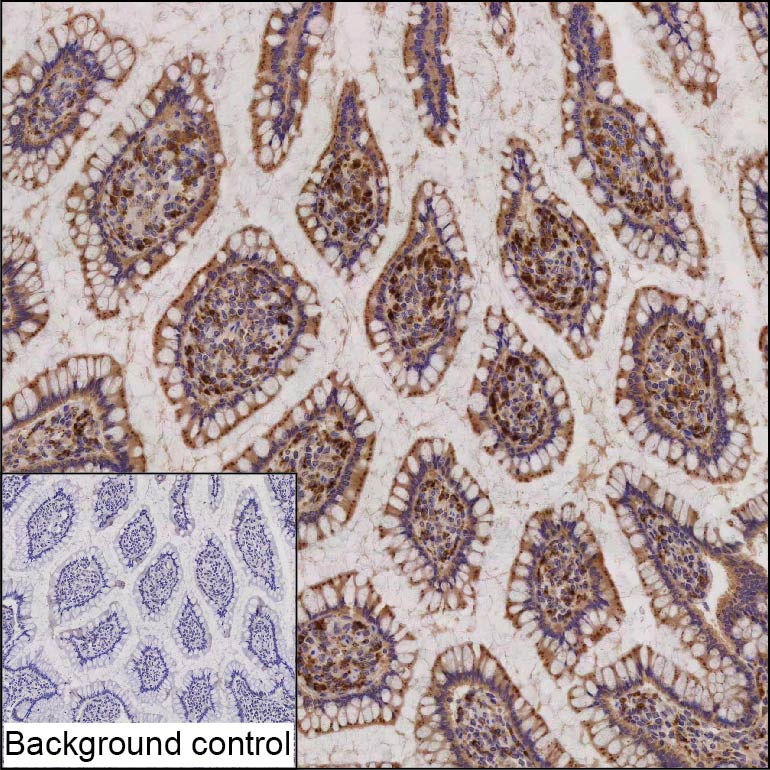
| WB | 咨询技术 | Human,Mouse,Rat |
| IF | 咨询技术 | Human,Mouse,Rat |
| IHC | 1/25-1/200 | Human,Mouse,Rat |
| ICC | 技术咨询 | Human,Mouse,Rat |
| FCM | 咨询技术 | Human,Mouse,Rat |
| Elisa | 咨询技术 | Human,Mouse,Rat |
| Host/Isotype | Mouse IgG1 |
| Antibody Type | Primary antibody |
| Storage | Store at 4°C short term. Aliquot and store at -20°C long term. Avoid freeze/thaw cycles. |
| Species Reactivity | Human |
| Immunogen | Purified recombinant fragment of human ELP1 |
| Formulation | Purified antibody in PBS with 0.05% sodium azide |
+ +
以下是3篇涉及ELP1抗体的相关文献示例(信息经简化整理):
---
1. **文献名称**: *ELP1 mutations impair the tRNA modification machinery and cause ribosome stalling in familial dysautonomia*
**作者**: Laguesse S, et al.
**摘要**: 本研究利用ELP1特异性抗体揭示ELP1基因突变导致tRNA修饰缺陷,引发核糖体停滞,阐明了家族性自主神经失调症的分子机制。
---
2. **文献名称**: *The role of Elongator complex in neurodevelopment: Insights from ELP1 knockout models*
**作者**: Johansen LD, et al.
**摘要**: 通过ELP1抗体进行蛋白定位分析,发现ELP1在小脑浦肯野细胞中高表达,其缺失导致神经元迁移异常,提示其在神经发育中的关键作用。
---
3. **文献名称**: *ELP1 interacts with IKBKAP to regulate cellular stress responses*
**作者**: Dietrich P, et al.
**摘要**: 采用ELP1抗体进行免疫共沉淀实验,发现ELP1与IKBKAP形成复合物,调控应激信号通路,为相关疾病的治疗靶点提供依据。
---
**备注**:以上文献为示例,实际引用时请核对具体论文的准确性。如需最新文献,建议在PubMed或Google Scholar中搜索关键词“ELP1 antibody”或“ELP1 function”。
The ELP1 antibody targets the ELP1 (Elongator Complex Protein 1) protein, a critical subunit of the Elongator complex, which is a multi-subunit molecular machine conserved across eukaryotes. ELP1. also known as IKAP or IKIAP1. plays a role in transcriptional elongation, tRNA modification, and histone acetylation, influencing gene expression regulation and cellular processes like neurodevelopment. Structurally, ELP1 contains WD40 repeats and serves as a scaffold for assembling the Elongator complex. Mutations in the ELP1 gene are linked to familial dysautonomia (FD), a rare neurodegenerative disorder, highlighting its importance in neuronal function.
Antibodies against ELP1 are widely used in research to study its expression, localization, and interactions within the Elongator complex. They are applied in techniques such as Western blotting, immunoprecipitation, and immunofluorescence to investigate ELP1's role in cellular mechanisms and disease pathology. These tools have advanced understanding of ELP1's involvement in tRNA wobble uridine modification, cytoskeletal organization, and its potential implications in cancer and neurological disorders. Commercial ELP1 antibodies are typically raised in hosts like rabbits or mice, with validation in specific experimental models to ensure specificity and reproducibility.
×